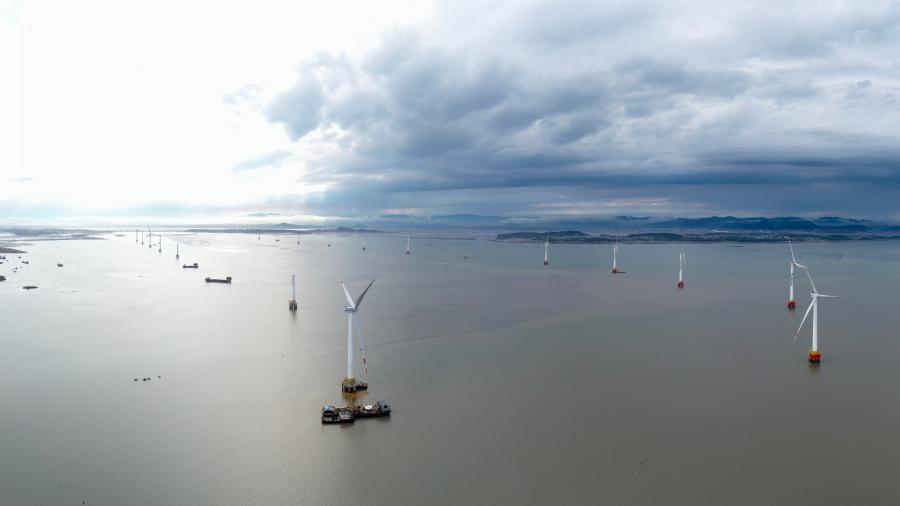China takes concrete actions towards tackling climate change
China’s active response towards tackling climate change provides robust evidence to refute US President Biden’s remarks at COP26 that China just "walked away" and it is "a gigantic issue".
China has implemented a national strategy of actively responding to climate change. Compared with developed countries, which generally have set a timeframe of 40 to 70 years before shifting from carbon peaking to carbon neutrality, China, the largest developing country in the world, made a solemn promise to peak its carbon dioxide emissions before 2030 and achieve carbon neutrality before 2060. This means that China will complete the world’s largest reduction in carbon dioxide emissions intensity in the shortest time ever in global history.

The aerial photo taken on May 28, 2021, shows an offshore wind power project under construction in Fujian Province. (Xinhua/Jiang Kehong)
China has announced a series of targets for nationally determined contributions and concrete policies and measures, setting out timetables, roadmaps and blueprints, issuing master plans, and setting clear objectives for each stage. China has put forward 10 major actions for peaking carbon dioxide emissions and has moved faster to put in place a “1+N” policy framework for carbon peaking and carbon neutrality.
Recently, China has started the construction of a batch of large wind power and photovoltaic bases with a combined installed capacity of 30 million kW, marking the beginning of the first phase of projects with an installed capacity of approximately 100 million kW. This speaks volumes about China’s resolve towards countering climate change.
According to a report from the International Energy Agency, to achieve net-zero emissions by 2050, almost 90 percent of global electricity generation needs to come from renewable sources. China has taken the lead in this regard, with the country having constructed the largest volume of solar power and wind power generators in the world. Compared with 2005, the installed capacities in China for photovoltaic solar energy expanded by over 3,000 times and 200 times for wind energy. China's carbon intensity in 2020 was 48.4 percent less than that in 2005, which means that China had more than fulfilled its commitment to the international community – achieving a 40 to 45 percent reduction in carbon intensity by 2020 from 2005 levels. The drop in carbon intensity translates into a total reduction of about 5.8 billion tons of carbon dioxide emissions. Electricity generated using non-fossil fuel energy represents more than one third of the country’s overall power consumption. China has been taking extra actions to scale up its efforts to tackle climate change. All these achievements give full expression to China’s vigorous measures, winning widespread praise from the international community.
As a common challenge for the world, climate change should be addressed by all of mankind. And coping with this fundamental issue of our times will contribute to the building of a community with a shared future for mankind. China has all along undertaken due international responsibilities commensurate with its own national conditions, practiced true multilateralism, and contributed to a fair, reasonable and win-win global climate governance system.
China promoted the signing and entry into force of the Paris Agreement, the third international agreement on climate change following the United Nations Framework Convention on Climate and the Kyoto Protocol. China has also contributed Chinese wisdom to the improvement of the Paris Agreement and has played a critical role in the implementation of the agreement even after the US decided to unilaterally withdraw from it.
China has led innovative forms of multilateral cooperation, stepped up support for other developing countries in developing green and low-carbon energy, and carried out South-South cooperation on climate change. China has provided assistance and support for developing countries to the best of its capacity under the framework of South-South cooperation on climate change, including donating energy conservation and new energy products and devices to almost 40 countries, helping relevant countries launch meteorological satellites, and training nearly 1,500 officials and technical personnel working in the climate response sector of 120 developing countries.
As the largest developing country, China has overcome its own economic and social difficulties to make tangible contributions to global climate governance and the fight against climate change. In the meantime, it remains crystal clear that the US has done nothing other than having continually “walked away” from stepping up and stepping forward on the issue of climate change.
Photos
Related Stories
- Why China's climate change dedication credible and attainable
- China contributes to global carbon emissions reduction
- All lip service, no actions -- Developed countries urged to walk the talk on climate crisis
- A divided America casts a shadow on global response to climate change
- China urges developed countries to intensify efforts on climate change
- U.S. withdrawal from Paris Agreement wastes world 5 years to tackle climate change: Chinese envoy
Copyright © 2021 People's Daily Online. All Rights Reserved.










